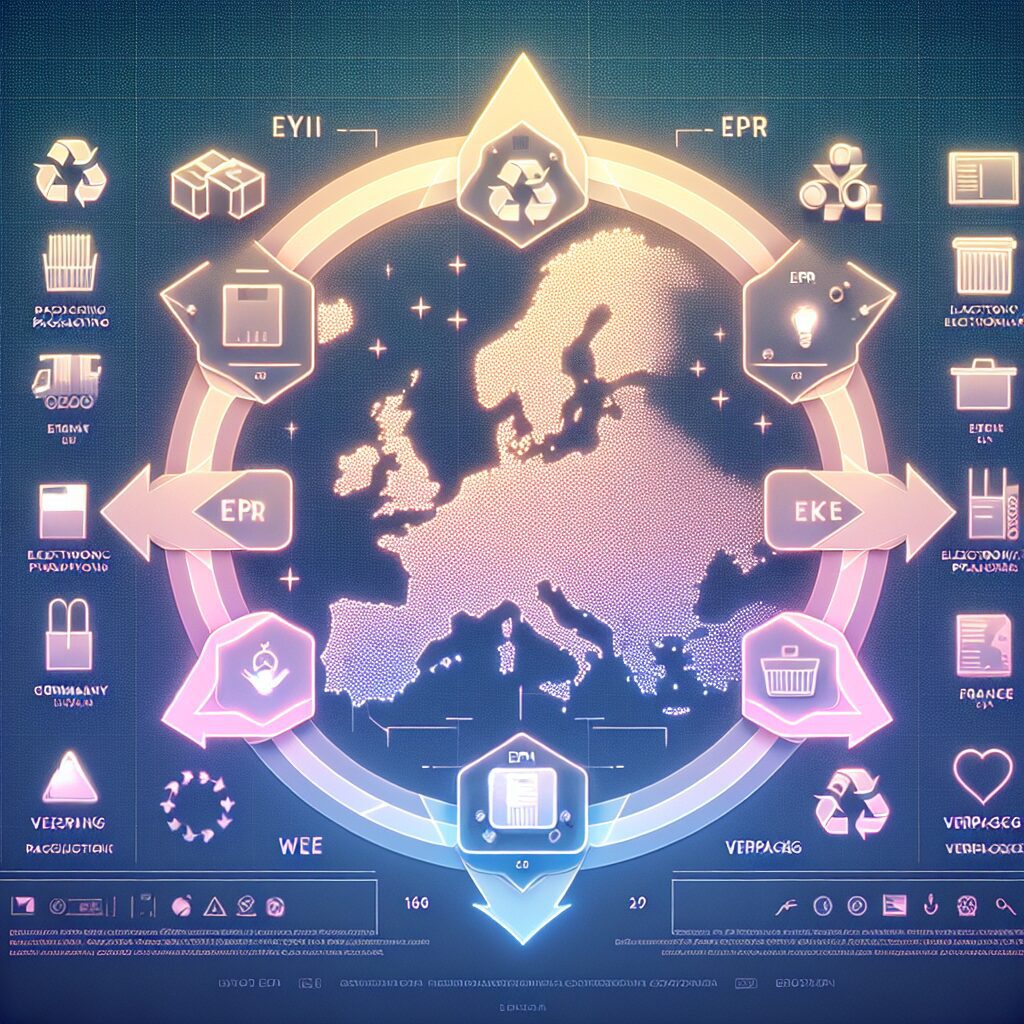About eldris
At Eldris, we automate SEO, multilingual site expansion, and EU compliance for brands scaling across Europe. Our AI-powered platform handles everything from content publishing to regulatory docs—so you don’t have to.
In This Article
- All producers selling into the EU must investigate their EPR compliance obligations based on product and packaging types.
- WEEE regulations govern electronic goods, while VerpackG applies to most packaged goods, even from overseas sellers.
- German EPR registration through the LUCID Register is mandatory for packaging-related obligations.
- Each EU country operates specific schemes—compliance obligations are not transferable cross-border.
- Automation tools and compliance consultants can streamline multi-country registrations and reduce legal risk.
What Is EPR Compliance and Why It Matters
Understanding Extended Producer Responsibility
Extended Producer Responsibility (EPR compliance) refers to a regulatory framework that holds producers accountable for the full lifecycle of the products they place on the market. This includes post-consumer waste management, such as collection, recycling, and final disposal. EPR compliance is embedded in European Union (EU) environmental legislation that seeks to mitigate the ecological impact of manufactured goods.

The core idea behind EPR compliance is that producers, rather than consumers or municipalities, must bear financial and logistical responsibility. The scheme aims to incentivise sustainable product design, foster eco-friendly packaging choices, and reduce landfill use. For businesses selling products into the EU, this means potentially needing to register under multiple schemes based on the types of goods and materials distributed.
Failure to align with EPR compliance requirements in each member state can result in substantial fines, blocked shipments, or delisting from e-commerce platforms. As more countries strengthen their producer responsibility standards, ignoring compliance obligations is a business risk no one can afford.
WEEE Directive: Electronic Waste Regulations Explained
Compliance for Electrical and Electronic Equipment
The Waste Electrical and Electronic Equipment (WEEE) Directive is one of the central pillars of EPR compliance concerning electronics. The directive mandates that producers and importers of electrical and electronic equipment sold in the EU take back used products, finance recycling, and report annually on quantities placed on the market and collected.
Categorised into various equipment types—ranging from IT devices and monitoring tools to household appliances—the WEEE framework ensures proper e-waste handling and minimises environmental harm. Registration is carried out via national registers, and producers must display a crossed-out wheeled bin symbol to inform consumers not to discard electronic goods with household waste. In Germany, for instance, registration under Stiftung EAR is mandatory.
Moreover, companies must submit periodic compliance reports and work closely with authorised take-back schemes to track collection and treatment. It’s crucial to distinguish between product types and sales modalities (e.g., B2B vs B2C), as these impact your responsibilities. Some small sellers mistakenly assume such requirements apply only to large corporations—this isn’t the case.
“If you sell electronics into the EU, WEEE compliance isn’t optional—it’s legally binding and strictly enforced.”
German Packaging Law (VerpackG): What Sellers Must Know
The German Packaging Act, known locally as VerpackG, governs packaging waste. Under this law, any business placing packaged goods onto the German market—regardless of size or physical presence—must register with the LUCID Packaging Register and participate in a dual system for recycling. This requirement applies even to ecommerce sellers shipping from abroad.
There are three types of packaging under VerpackG: sales packaging, secondary packaging, and transport packaging. Most online retailers fall under the first two. Registration involves declaring volumes and materials, paying for recycling through a licensed scheme, and ensuring labelling and data reporting are correct and up to date.
Key point: Unlike WEEE, VerpackG applies even to non-electronic products. For example, if you’re shipping tea in sachets packaged within cartons, both layers may fall under VerpackG obligations. Companies that ignore this face potential legal enforcement from the Zentrale Stelle Verpackungsregister (ZSVR), the German packaging authority.
To remain compliant, use local compliance solutions or consult a legal expert. Automation tools can also help monitor packaging declarations and deadlines, which are often strict and recurring.
Do I Need to Register Under Multiple Compliance Laws?
Yes, often you must. EPR compliance is not a one-size-fits-all requirement. Instead, different laws target distinct product categories. If you sell electrical goods packed in cartons to a German customer, you’ll likely fall under both WEEE and VerpackG.
Each directive operates under its own legal framework, administrative body, and producer obligations. Moreover, obligations vary based on product categories, sales channels, and even the country of sale. A seller registered for WEEE in France isn’t automatically compliant under Germany’s EPR systems.
This means your company may need to maintain separate compliance accounts and submit country-specific declarations. Ignorance of these requirements is not a viable defence in the face of audits and enforcement actions. Therefore, assess your obligations for each operating country and product type. Tools exist to simplify this, but strategic oversight remains necessary.
How to Assess Your Product Obligations
Begin by identifying which product categories you place into EU markets. Are they electrical, electronic, or do they involve packaging components? Consider the following checkpoints:
- Type of products sold (e.g., electronics, toys, toiletries)
- Destination countries within the EU
- Packaging materials used (e.g., glass, plastic, cardboard)
- End-customer type (business vs consumer)
- Legal structure and shipping methods
Once identified, map these to the relevant compliance directives (EPR, WEEE, VerpackG, or others like batteries or textiles). Use government portals to verify whether you need to register. Some industries offer tools or checklists designed for sector-specific compliance mapping. Learn more about EU E-commerce Compliance & Producer Responsibility
EU EPR Compliance in Practice: Use Cases
Consider a French cosmetics brand selling moisturisers to customers in Germany. If the products are packaged in plastic tubes inside cardboard boxes, the company must ensure VerpackG compliance. Now, contrast that with a UK business shipping refurbished laptops to France, Spain, and Belgium. This case requires compliance with WEEE rules in those specific countries, each demanding local registration and reporting.
Another example is an apparel brand shipping across multiple EU markets. If clothes ship in branded packaging with supplementary bubble wrap, both the outer and inner packaging may trigger VerpackG or other packaging EPR schemes. Here, automation offers great relief—monitoring declarations, generating reports, and sending renewal alerts automatically.
Lastly, dropshippers selling through online marketplaces must evaluate whether the marketplace handles compliance or if the seller retains responsibility. Misunderstanding this dynamic can cause flagging by platforms like Amazon or Etsy for non-compliance. When in doubt, consult your platform’s compliance policy or legal counsel. Read a related article
What Is the LUCID Register and How Do You Join?
The LUCID Packaging Register is Germany’s public database for packaging compliance. Required under VerpackG, it allows authorities and the public to verify whether a producer is registered for recycling obligations. All companies, whether domestic or international, must create a LUCID account before placing packaged goods onto the German market.
Joining involves entering corporate identification data, specifying packaging volumes, appointing an authorised representative (if operating from outside Germany), and contracting with a dual system, such as Der Grüne Punkt. Critical deadlines apply for annual declarations in January for the prior year’s activity.
After registration, your LUCID number should appear on invoices or customs forms when appropriate. Operating without a LUCID registration is termed “illegal packaging distribution” and may incur penalties. Transparency and timing are crucial for avoiding scrutiny. Documentation must be retained for inspection if audits occur.
The Role of Country-Specific Compliance Schemes
While EPR compliance has EU-wide principles, enforcement and execution are carried out via country-level compliance schemes. These are government-approved bodies tasked with managing the physical recycling process, data collection, and enforcement oversight for each applicable directive.
Examples include EcoEmballages in France for packaging, Recupel in Belgium for electronic goods, and ERP Spain for multiple product categories. Collaborating with these schemes ensures that your product registrations, volumes, and contributions are officially recognised and accounted for.
Each scheme will have its own set of administrative rules, fee structures, and reporting schedules. Some allow online submissions in English, while others mandate local partners or language. Familiarising yourself with your scheme’s peculiarities is not merely advisable—it’s a cornerstone of multi-country EPR compliance.
You can often find these schemes via government environment portals or compliance directories. In some cases, cross-border producer services or compliance agents can help you interface with schemes you don’t have language capabilities for. Guide to VerpackG and LUCID registration
Automating EPR, WEEE, and VerpackG for Your Brand
Managing EPR compliance manually across multiple markets quickly becomes untenable. Compliance automation platforms offer a scalable solution for maintaining registrations, uploading documentation, paying scheme fees, and tracking legal updates across jurisdictions. These tools align with supply chain systems and integrate APIs where possible.
Leading services allow you to submit electronic product volumes, declare packaging weights, and receive deadline alerts. They may even connect directly with national registers for performance tracking and alert you to new legislative requirements. Automation is especially valuable for sellers diversifying channels and sales volumes across EU countries.
However, automation doesn’t eliminate liability. Sellers must still verify accuracy and maintain records. Collaborative compliance workflows—where operations, legal, and sustainability teams are aligned—help mitigate risk and ensure business expansions are legally sound.
Final Thoughts: Future-Proofing Your EU Compliance
EPR compliance is not a one-time registration. It is a strategic, ongoing commitment to environmental stewardship, business transparency, and legal alignment for companies operating across the European Union. As regulations become more stringent and real-time reporting becomes the norm, staying ahead requires systemised processes, automation tools, and ongoing legal awareness.
To future-proof your EU operations, regularly audit your product lines, stay informed on country-specific legislative amendments, and invest in scalable compliance solutions. Whether you’re just entering the EU market or expanding into additional territories, proactive EPR compliance isn’t just about avoiding fines—it’s about sustainability and business longevity.
Great guide on epr-vs-weee-vs-verpackg-what-applies-interactive – Community Feedback
What is the difference between EPR, WEEE, and VerpackG?
EPR covers a range of product types in the EU, WEEE specifically addresses electrical and electronic waste, and VerpackG governs packaging waste management in Germany. Each regulation applies to different products and requires separate compliance steps.
Does my brand need to register for multiple schemes?
If your brand sells to or within the EU and handles electronics, batteries, or packaged goods, you may need to register under more than one compliance scheme—such as EPR for packaging and WEEE for electronics.
How can I check which regulations apply to my business?
Review your product categories and countries where you sell. Use checklists and regulatory guides for EPR, WEEE, and VerpackG to identify the necessary registrations and ongoing compliance duties for each market.








